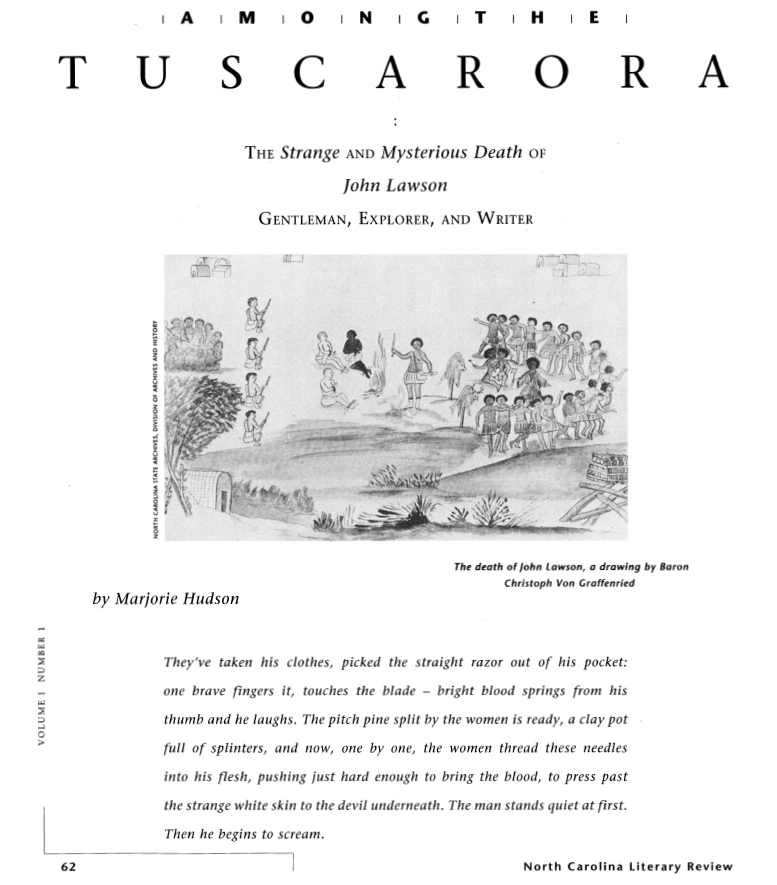Friday from the Archives: “Among the Tuscarora: The Strange and Mysterious Death of John Lawson, Gentleman, Explorer, Writer” by Marjorie Hudson from NCLR 1 (1992).
Because NCLR has always been the companion journal to the North Carolina Literary & Historical Association Historical Review, we have often published stories at the crossroads of both topics. And because language shifts and we are always trying to correctly portray history, even in the thirty years since we started publishing, the way we may talk about a piece of literature has changed.
In our first issue in 1992, Marjorie Hudson wrote an incredible in-depth piece about one of North Carolina’s first famous pieces of writing: John Lawson’s 1709 book A New Voyage to Carolina. “In May 1700, John Lawson, filled with the spirit of adventure, set sail for the New World, heading for North Carolina on the advice of a world traveler he had met by chance in England…. As he traveled, he collected plant specimens for a London botanist; he also kept a journal describing the New World plants and wildlife…. But his most compelling records are those describing Eden’s native inhabitants.”
Lawson was probably as neutral as European colonizers were likely to be in his documentation of the tribes of Native Americans he encounters on his long journey up from Charleston, SC through the NC Piedmont, eventually settling in the port town of Bath before his untimely demise at the hands of the Tuscarora. And Hudson writes about the settlers encroachment into Indian lands, the specters of smallpox and rum ravaging the tribes, and colonizers enslaving Native Americans.
Even as essentially a marketing piece, his book is important to the annals of North Carolina history in that it gives us first-hand knowledge of who and what was here in the early 1700s. How much more critical it is to also share the voices of the Native Americans who were here–as Melissa D. Birkhofer and Paul M. Worley do in their John Ehle Prize essay “She Said That Saint Augustine is Worth Nothing Compared to Her Homeland: Teresa Martín and the Méndez Cancio Account of La Tama (1600)”–and those who are still here–as the featured theme “Native American Literature of North Carolina” in our three issues this year has done. We can hope that one day a piece of Tuscarora writing may be found to add primary source information to the historical record of early North Carolina.
Included with the essay are several sidebar pieces, including “North Carolina’s Native Americans” by Jim Shamlin, which he closes with “Today, only the Cherokee remain as a recognized nation. The rest are generally remembered, it at all, by their legends and occasional excavations, or by the many Native American-derived names which North Carolinians still use for crossroads, towns, counties, rivers, and ridges.” If you’ve ever crossed the Pee Dee River, gone to Ocracoke, or visited the largest natural lake in North Carolina at the Mattamuskeet National Wildlife Refuge, you know of a Native tribe. Dozens others are listed with the essay–read it to see just how many you recognize.
Learn more about historical and contemporary North Carolina Native Americans at the 28th Annual American Indian Heritage Celebration in downtown Raleigh on November 18th.
Read the entire essay in the 1992 issue at ECU’s Joyner Library Digital Collection or order it for your collection.
